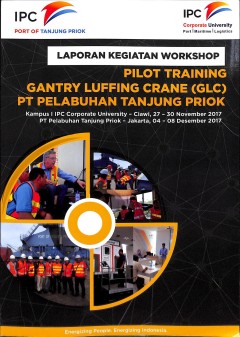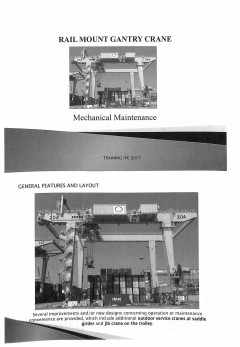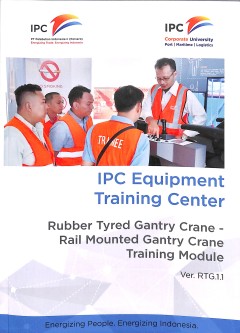Ditapis dengan

Mobile Crane Manual
- Edisi
- -
- ISBN/ISSN
- 0-408-01459-8
- Deskripsi Fisik
- 353 p
- Judul Seri
- -
- No. Panggil
- TXT SC DIC m
- Edisi
- -
- ISBN/ISSN
- 0-408-01459-8
- Deskripsi Fisik
- 353 p
- Judul Seri
- -
- No. Panggil
- TXT SC DIC m

laporan kegiatan workshop pilot training gantry lutfing crane (glc) pt pelabu…
- Edisi
- -
- ISBN/ISSN
- -
- Deskripsi Fisik
- 15 halaman
- Judul Seri
- -
- No. Panggil
- IPC REP 2017 GAN g C.1
- Edisi
- -
- ISBN/ISSN
- -
- Deskripsi Fisik
- 15 halaman
- Judul Seri
- -
- No. Panggil
- IPC REP 2017 GAN g C.1

laporan pelaksanaan kegiatan asesmen calon peserta pelatihan rubber tyred gan…
- Edisi
- -
- ISBN/ISSN
- -
- Deskripsi Fisik
- 7 halaman
- Judul Seri
- -
- No. Panggil
- IPC REP 2016 RUB r C.1
- Edisi
- -
- ISBN/ISSN
- -
- Deskripsi Fisik
- 7 halaman
- Judul Seri
- -
- No. Panggil
- IPC REP 2016 RUB r C.1

Mobile Crane Manual
The Crane Handbook and the Rigging Manual, this manual is intended to be of general interest and use to contractors, supervisors and other personnel involved in crane operations. More specifically, the manual has been published to provide information crucial in educating and training crane operators and apprentices. Mobile cranes are becoming larger, more expensive and more sophisticated all t…
- Edisi
- -
- ISBN/ISSN
- 0-408-01459-8
- Deskripsi Fisik
- 353 p., : illus : 25 cm
- Judul Seri
- -
- No. Panggil
- TXT PO BUT m C.1

Crane Scheduling in Container Terminals : Mathematical Models, Heuristics and…
The globalization of trade has lead to an enormous growth in sea transportation over the last years. A great majority of general cargo is containerized and handled in container terminals, which are essential hubs in sea transportation systems. The potential of cost saving in a container terminal is large and the workflow of a container terminal has to be very efficient. The focus of this book l…
- Edisi
- -
- ISBN/ISSN
- 978-3-639-04236-8
- Deskripsi Fisik
- 59p. ; 23cm.
- Judul Seri
- -
- No. Panggil
- TXT PO BOH c

Quay crane scheduling in container terminals
The problem of scheduling identical quay cranes moving along a common linear rail to handle containers for a ship is studied. The ship has a number of container-stacking compartments called bays, and only one quay crane can work on a bay at the same time. The objective of the scheduling problem is to find the work schedule for each quay crane which minimizes the ship’s stay time in port. Find…
- Edisi
- Vol. 38, No. 6, September 2006, 723–737
- ISBN/ISSN
- 1029-0273
- Deskripsi Fisik
- 16 p.
- Judul Seri
- Engineering Optimization
- No. Panggil
- ATC LO CNG q

Hybrid Estimation of Distribution Algorithm for the Quay Crane Scheduling Pro…
The competitiveness of a container terminal is highly conditioned by the time that container vessels spend on it. The proper scheduling of the quay cranes can reduce this time and allows a container terminal to be more attractive to shipping companies. The goal of the Quay Crane Scheduling Problem (QCSP) is to minimize the handling time of the available quay cranes when performing the tasks of …
- Edisi
- 2013
- ISBN/ISSN
- 4063–4076
- Deskripsi Fisik
- 14 p.
- Judul Seri
- Applied Soft Computing
- No. Panggil
- ATC LO IZQ h

Gantry Crane Scheduling with Interference Constraints in Railway Container Te…
Railway container terminals, where gantry cranes are responsible for loading and unloading containers between freight trains and yards, are important hubs of hinterland logistics transportation. Terminal managers confront the challenge in improving the efficiency of their service. As the most expensive equipment in a terminal, the operational performance of gantry cranes is a crucial factor. In…
- Edisi
- Vol. 6, No. 2 (March, 2013), 244-260
- ISBN/ISSN
- -
- Deskripsi Fisik
- 18 p.
- Judul Seri
- International Journal of Computational Intelligence Systems
- No. Panggil
- ATC LO GUO g

ADVANCES IN CONTAINER CRANES AUTOMATION
This paper summarizes the most important advances of the used crane control technology in perspective of automatic operation of container cranes. Faster and more productive container cranes demands highly efficient yard system. Storage capacity is the limitation for most terminals today; automatic operation offers optimum stacking density and peak capacity equivalent for continuous manning of e…
- Edisi
- October 12-14, 2009
- ISBN/ISSN
- -
- Deskripsi Fisik
- 5p
- Judul Seri
- ADVANCES IN CONTAINER CRANES AUTOMATION
- No. Panggil
- ATC LO SLU a

Aggregates cranes handling capacity of container terminals: the port of Kaohs…
This study looks at the degrees of interference for multiple cranes that work simultaneously at six major container terminals in the port of Kaohsiung. The results con®rm that there are di erent degrees of mutual crane interference among terminals where di erent operational modes are adapted in the container yards. RTG handling systems show a very high value of aggregate cranes exponent f…
- Edisi
- VOL. 29, NO. 4, 341±350
- ISBN/ISSN
- 1464±5254
- Deskripsi Fisik
- 12p
- Judul Seri
- Maritime Policy & Management: The flagship journal of international shipping and port research
- No. Panggil
- ATC LO CHU a

A simulation optimization approach for solving the dual-cycling problem in co…
Dual cycling is an operation technique whereby quay cranes perform loading and unloading operations simultaneously in the same ship bay. In this article, a mixedinteger programming model for quay crane dual-cycling scheduling is developed. The model considers the stowage plan of outbound containers and the operation sequence of quay cranes. To solve the model, a heuristic method, called bi-leve…
- Edisi
- 2015
- ISBN/ISSN
- -
- Deskripsi Fisik
- 23p
- Judul Seri
- Maritime Policy & Management: The flagship journal of international shipping and port research
- No. Panggil
- ATC LO ZEN a

A Routing Algorithm for a Single Transfer Crane to Load Export Containers ont…
It is discussed how to route transfer crane during loading operation of export containers in port container terminal. We determine the number of containers which transfer crane picks up at each yard-bay as well as the sequence of yard-bays which transfer crane visits during the tour. The objective is to minimize the total container handling time of the transfor crane including the set-up time a…
- Edisi
- Vol. 33, Nos 3-4, pp. 673-676, 1997
- ISBN/ISSN
- -
- Deskripsi Fisik
- 4p
- Judul Seri
- A Routing Algorithm for a Single Transfer Crane to Load Export Containers onto a Containership
- No. Panggil
- ATC LO KIM a

Laporan kagiatan workshop pilot training gantry luffing crane (GLC) PT Pelabu…
- Edisi
- 27-30 November 2017 & 04-08 Desember 2017
- ISBN/ISSN
- -
- Deskripsi Fisik
- 15 p.
- Judul Seri
- -
- No. Panggil
- IPC REP PIL p
- Edisi
- 27-30 November 2017 & 04-08 Desember 2017
- ISBN/ISSN
- -
- Deskripsi Fisik
- 15 p.
- Judul Seri
- -
- No. Panggil
- IPC REP PIL p

Laporan kegiatan workshop pilot training luffing crane (glc) pt pelabuhan tan…
- Edisi
- 27-30 Nopember 2017
- ISBN/ISSN
- -
- Deskripsi Fisik
- 45p, 29 cm
- Judul Seri
- -
- No. Panggil
- IPC REP 2017 PEN p
- Edisi
- 27-30 Nopember 2017
- ISBN/ISSN
- -
- Deskripsi Fisik
- 45p, 29 cm
- Judul Seri
- -
- No. Panggil
- IPC REP 2017 PEN p

Study on berth planning problem in a container seaport: Using an integrated p…
This paper provides an integrated solution for two common processes in a container seaport: namely, the Berth Allocation Process (BAP) and the Crane Scheduling Process (QCSP). These are formulated through a Bi-Level Programming (BLP) approach, which is used to characterize the highly interrelated relationships between the two processes and simultaneously, identify an integrated solution for bot…
- Edisi
- -
- ISBN/ISSN
- 0360-8352
- Deskripsi Fisik
- 10 p.
- Judul Seri
- Computers & Industrial Engineering
- No. Panggil
- ATC PO ONG s

Multi-objective optimization for the train load planning problem with two cra…
This paper deals with the train load planning problem arising in seaport terminals. In particular, the train load planning problem in case of two cranes is studied, corresponding to the optimal assignment of containers to the wagons on which they are loaded and to the cranes which perform the loading operations. This optimal assignment is realized by considering the simultaneous optimization of…
- Edisi
- -
- ISBN/ISSN
- -
- Deskripsi Fisik
- 8 p.
- Judul Seri
- -
- No. Panggil
- ATC PO AMB m

A simulation-based Genetic Algorithm approach for the quay crane scheduling u…
- Edisi
- -
- ISBN/ISSN
- -
- Deskripsi Fisik
- 175 p.
- Judul Seri
- -
- No. Panggil
- ATC PO DIA a
- Edisi
- -
- ISBN/ISSN
- -
- Deskripsi Fisik
- 175 p.
- Judul Seri
- -
- No. Panggil
- ATC PO DIA a

A genetic algorithm heuristic for solving the quay crane scheduling problem w…
One of the most important operations in marine container terminals is quay crane scheduling. The quay crane scheduling problem (QCSP) involves scheduling groups of containers to be loaded and unloaded by each quay crane. It also requires addressing practical issues such as minimum spacing between quay cranes and precedence relationships between container groups. This study addresses the QCSP wi…
- Edisi
- Maritime Economics & Logistics (2015) 17, 515–537
- ISBN/ISSN
- -
- Deskripsi Fisik
- 23 pages
- Judul Seri
- -
- No. Panggil
- ATC PO KAV g

Decision support for yard capacity, fleet composition, truck substitutability…
This paper presents the results of nine independent studies that link a seaport container terminal’s long-run average quay crane rate to various strategic and tactical decisions made by the terminal operating company. New numerical results on yard capacity, fleet composition, truck substitutability, and terminal scalability issues are obtained using a fully-integrated, discrete event simulati…
- Edisi
- -
- ISBN/ISSN
- -
- Deskripsi Fisik
- 19 p.
- Judul Seri
- -
- No. Panggil
- ATC PO PET a

Operations research for the management of a transhipment container terminal: …
In this work we describe some decisional problems arising in the management of maritime container ports, together with optimisation models and algorithms suitably designed for their solution. We refer to the Gioia Tauro container terminal which recently has reached a high stage of growth, becoming one of the most important transhipment ports in the Mediterranean Sea. In particular, we focus on …
- Edisi
- March 2009, Volume 11
- ISBN/ISSN
- -
- Deskripsi Fisik
- 20 p.
- Judul Seri
- Maritime Economics & Logistics
- No. Panggil
- ATC LO SAM o

Integrated berth allocation and quay crane assignment problem : set partition…
Most of the operational problems in container terminals are strongly interconnected. In this paper, we study the integrated Berth Allocation and Quay Crane Assignment Problem in seaport container terminals. We will extend the current state-of-the-art by proposing novel set partitioning models. To improve the performance of the set partitioning formulations, a number of variable reduction techni…
- Edisi
- -
- ISBN/ISSN
- -
- Deskripsi Fisik
- 23 p.
- Judul Seri
- -
- No. Panggil
- ATC PO LAR i

Housekeeping : foresightful container repositioning
- Edisi
- -
- ISBN/ISSN
- 0925-5273
- Deskripsi Fisik
- 9 p.
- Judul Seri
- Int. J.ProductionEconomics
- No. Panggil
- ATC PO EHL
- Edisi
- -
- ISBN/ISSN
- 0925-5273
- Deskripsi Fisik
- 9 p.
- Judul Seri
- Int. J.ProductionEconomics
- No. Panggil
- ATC PO EHL

Development and simulation analysis of real-time, dual-load yard truck contro…
We show how a seaport container terminal’s long-run average quay crane rate depends on the system that automatically assigns yard trucks to container transportation jobs in the terminal in real time. Several real-time, dual-load yard truck control systems are proposed and evaluated by a fully-integrated, discrete event simulation model of a vessel-to-vessel transshipment terminal. The model i…
- Edisi
- -
- ISBN/ISSN
- -
- Deskripsi Fisik
- 29 p.
- Judul Seri
- REGULAR ARTICLE
- No. Panggil
- ATC LO PET d

An Integrated Model for Berth Template and Yard Template Planning in Transshi…
This paper studies two tactical level decision problems arising in transshipment hubs: berth template planning that is concerned with allocating berths and quay cranes to arriving vessels, and yard template planning that is concerned with assigning yard storage locations to vessels. These two tactical level decisions interact with each other. A mixed-integer programming model is proposed to int…
- Edisi
- Vol. 45, No. 4, November 2011
- ISBN/ISSN
- -
- Deskripsi Fisik
- 23 p.
- Judul Seri
- -
- No. Panggil
- ATC LO LEE a

A study of the changes in performance of quayside container cranes
The learning effect, whereby performance improves with experience, is well documented for manufacturing situations. This article applies these learning concepts to quayside container cranes, in order to determine the relationship between number of containers moved and unloading time. The results show that crane performance has improved with time, and that the learning effect is essentially the …
- Edisi
- -
- ISBN/ISSN
- -
- Deskripsi Fisik
- 11 p.
- Judul Seri
- Maritime Policy & Management: The flagship journal of international shipping and port research
- No. Panggil
- ATC LO TAB a

Rail mount gantry crane : mechanical maintenance
- Edisi
- -
- ISBN/ISSN
- -
- Deskripsi Fisik
- -
- Judul Seri
- -
- No. Panggil
- IPC GUI RAI r
- Edisi
- -
- ISBN/ISSN
- -
- Deskripsi Fisik
- -
- Judul Seri
- -
- No. Panggil
- IPC GUI RAI r

IPC equipment training center : rubber tyred gantry crane - rail mounted gant…
- Edisi
- -
- ISBN/ISSN
- -
- Deskripsi Fisik
- 35 p.; 21 cm
- Judul Seri
- -
- No. Panggil
- IPC GUI EQU e
- Edisi
- -
- ISBN/ISSN
- -
- Deskripsi Fisik
- 35 p.; 21 cm
- Judul Seri
- -
- No. Panggil
- IPC GUI EQU e
 Karya Umum
Karya Umum  Filsafat
Filsafat  Agama
Agama  Ilmu-ilmu Sosial
Ilmu-ilmu Sosial  Bahasa
Bahasa  Ilmu-ilmu Murni
Ilmu-ilmu Murni  Ilmu-ilmu Terapan
Ilmu-ilmu Terapan  Kesenian, Hiburan, dan Olahraga
Kesenian, Hiburan, dan Olahraga  Kesusastraan
Kesusastraan  Geografi dan Sejarah
Geografi dan Sejarah